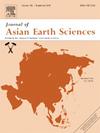青藏高原东北部龙日坝断裂温泉水文地球化学特征:地热流体循环的构造意义
IF 2.7
3区 地球科学
Q2 GEOSCIENCES, MULTIDISCIPLINARY
引用次数: 0
摘要
龙日坝断裂位于青藏高原东北部地震活跃区,但其构造动力学仍存在争议。此外,还没有研究通过地热流体循环来了解LRBF的构造活动。为了更好地了解流体循环与构造活动之间的过程和控制因素,本文对LRBF中的20个温泉进行了调查。水文地球化学结果表明,研究区温泉以大气降水补给为主,根据其水化学类型可分为两类。第1族为典型的HCO3-Ca,包括部分HCO3-Ca⋅Mg、HCO3-Mg和HCO3-Na⋅Ca。II类温泉为HCO3-Na型,储层温度高(平均94℃),深循环过程中主要与硅酸盐发生反应。同时,两组水的氢、氧、锶同位素也有显著差异。II组温泉均位于研究区西南段,其气体3He/4He比值较高(Rc/Ra比值达0.43 Ra)。水文地球化学结果结合地质和地球物理资料表明,补给标高、花岗岩分布和潜在的下地壳流动或部分熔融的差异导致了两组不同的水文地球化学特征。此外,我们认为3He/4He的空间分布暗示了LRBF下方的地壳流动和部分熔融。一种可能的解释是,在LRBF下方存在一条较低的地壳流动支流。在LRBF中,热液环流和深部构造可能是产生高频地震的关键因素。上述结果通过温泉的水文地球化学特征对区域构造活动提供了新的认识。本文章由计算机程序翻译,如有差异,请以英文原文为准。

Hydrogeochemical characteristics of hot springs in the Longriba fault, northeastern Tibetan Plateau: Tectonic implications for geothermal fluid circulation
The Longriba fault (LRBF) is in the seismically active northeastern Tibetan Plateau, yet the tectonic dynamics at the fault remain controversial. Furthermore, no studies have provided insights into tectonic activity through geothermal fluid circulation in the LRBF. In this study, we investigated 20 hot springs in the LRBF to get a better understanding of the processes and control factors between fluid circulation and tectonic activity. Hydrogeochemical results indicate that the hot springs in the study area are predominantly recharged by atmospheric precipitation and can be classified into two groups based on their hydrochemical types. Group I was a typical HCO3-Ca, including some HCO3-Ca⋅Mg, HCO3-Mg, and HCO3-Na⋅Ca. Group II hot springs, classified as HCO3-Na type, have high reservoir temperatures (average 94 °C), suggesting dominant reactions with silicates during deep circulation. Meanwhile, the hydrogen, oxygen, and strontium isotopes of water in the two groups also show significant differences. In addition, the Group II hot springs are all located in the southwest segment of the study area, and their gases have higher 3He/4He ratios (Rc/Ra ratios up to 0.43 Ra). Hydrogeochemical results, combined with geological and geophysical data, suggest that differences in recharge elevation, granite distribution, and potential lower crustal flow or partial melting contributed to the distinct hydrogeochemical characteristics of the two groups. Moreover, we supposed that the spatial distribution of 3He/4He implies a lower crustal flow and partial melting beneath the LRBF. One possible explanation is the presence of a lower crustal flow tributary beneath the LRBF. In the LRBF, hydrothermal circulation and deep tectonics are likely key factors in generating high-frequency earthquakes. The above results provide insights into regional tectonic activity through the hydrogeochemical characteristics of hot springs.
求助全文
通过发布文献求助,成功后即可免费获取论文全文。
去求助
来源期刊

Journal of Asian Earth Sciences
地学-地球科学综合
CiteScore
5.90
自引率
10.00%
发文量
324
审稿时长
71 days
期刊介绍:
Journal of Asian Earth Sciences has an open access mirror journal Journal of Asian Earth Sciences: X, sharing the same aims and scope, editorial team, submission system and rigorous peer review.
The Journal of Asian Earth Sciences is an international interdisciplinary journal devoted to all aspects of research related to the solid Earth Sciences of Asia. The Journal publishes high quality, peer-reviewed scientific papers on the regional geology, tectonics, geochemistry and geophysics of Asia. It will be devoted primarily to research papers but short communications relating to new developments of broad interest, reviews and book reviews will also be included. Papers must have international appeal and should present work of more than local significance.
The scope includes deep processes of the Asian continent and its adjacent oceans; seismology and earthquakes; orogeny, magmatism, metamorphism and volcanism; growth, deformation and destruction of the Asian crust; crust-mantle interaction; evolution of life (early life, biostratigraphy, biogeography and mass-extinction); fluids, fluxes and reservoirs of mineral and energy resources; surface processes (weathering, erosion, transport and deposition of sediments) and resulting geomorphology; and the response of the Earth to global climate change as viewed within the Asian continent and surrounding oceans.
 求助内容:
求助内容: 应助结果提醒方式:
应助结果提醒方式:


